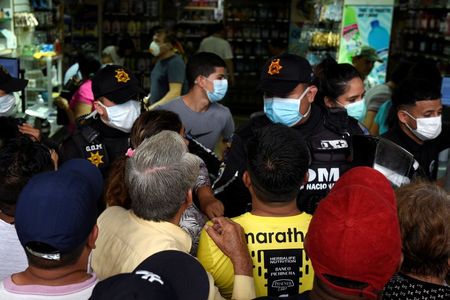
It seems quarantining patients with symptomatic Covid-19 will not be enough to stop the ongoing pandemic — a decision analytical model assessing SARS-CoV-2 transmissions estimated that asymptomatic individuals account for more than half of all transmission, researchers reported.
“In addition to identification and isolation of persons with symptomatic Covid-19, effective control of spread will require reducing the risk of transmission from people with infection who do not have symptoms,” wrote Jay C. Butler, MD, of the Office of the Deputy Director for Infectious Diseases at the CDC, and colleagues in JAMA Network Open. “These findings suggest that measures such as wearing masks, hand hygiene, social distancing, and strategic testing of people who are not ill will be foundational to slowing the spread of Covid-19 until safe and effective vaccines are available and widely used.”
As the Covid-19 pandemic swept across the globe in 2020, it became clear that, unlike its cousin SARS-CoV, SARS-CoV-2 was being transmitted by two groups of asymptomatic individuals — those who were presymptomatic and had yet to develop symptoms, and those who never developed symptoms over the course of infection. However, “measures to reduce transmission from individuals who do not have Covid-19 symptoms have become controversial and politicized and have likely had negative effects on the economy and many societal activities,” Butler and colleagues explained, adding that the importance of measures to mitigate asymptomatic transmission “has been disputed.”
To help make the argument for prioritizing control practices and policies aimed at reducing asymptomatic Covid-19 transmission, Butler and colleagues conducted a decision analytical study to determine the proportion of SARS-CoV-2 transmission that stems from individuals without symptoms.
“This decision analytical model assessed the relative amount of transmission from presymptomatic, never symptomatic, and symptomatic individuals across a range of scenarios in which the proportion of transmission from people who never develop symptoms (i.e., remain asymptomatic) and the infectious period were varied according to published best estimates,” they wrote. “For all estimates, data from a meta-analysis was used to set the incubation period at a median of 5 days. The infectious period duration was maintained at 10 days, and peak infectiousness was varied between 3 and 7 days (−2 and +2 days relative to the median incubation period). The overall proportion of SARS-CoV-2 was varied between 0% and 70% to assess a wide range of possible proportions.”
The study’s main outcome was level of transmission of SARS-CoV-2 from presymptomatic, never symptomatic, and symptomatic individuals.
The baseline assumptions used for the analytical model were that peak infectiousness occurred at the median of symptom onset (5 days) and that 30% of individuals with infection never develop symptoms and are 75% as infectious as symptomatic patients. Butler and colleagues estimated that, under these assumptions, asymptomatic Covid-19 patients accounted for approximately 59% of all transmission, with 35% stemming from presymptomatic individuals and 24% coming from individuals who were never symptomatic.
“Because each component is uncertain, we assessed different timings of peak infectiousness relative to illness onset and different proportions of transmission from individuals who never have symptoms,” they wrote. “Maintaining the 24% of transmission from individuals who never have symptoms, but shifting peak infectiousness 1 day earlier (to day 4) increased presymptomatic transmission to 43% and all asymptomatic transmission to 67% (Figure 1A). A later peak (ie, day 6) decreased presymptomatic to 27% and all asymptomatic transmission to 51%.”
Holding the day of peak infectiousness constant at day 5 and reducing the proportion of transmission from individuals who are never symptomatic to 10% while maintaining a relative infectiousness of 75% decreased the proportion of transmission from never symptomatic patients to 8% and increased presymptomatic transmission to 42%, for a total of 50%, Butler and colleagues noted; “In contrast, if the proportion of those who ever develop symptoms was 30% and their relative infectiousness increased to 100%, they contributed 30% of all transmission, presymptomatic transmission was 32%, and combined asymptomatic transmission was 62% of all transmission,” they wrote.
“Under a broad range of values for each of these assumptions, at least 50% of new SARS- CoV-2 infections was estimated to have originated from exposure to individuals with infection but without symptoms,” they added.
Butler and colleagues argued that these findings reinforce the importance of creating mitigation strategies designed to reduce asymptomatic Covid-19 transmission. “This overall proportion of transmission from presymptomatic and never symptomatic individuals is key to identifying mitigation measures that may be able to control SARS-CoV-2,” they wrote. “For example, if the reproduction number (R) in a given setting is 2.0, then at least a 50% reduction in transmission is needed to drive the reproductive number below 1.0. Given that in some settings R is likely much greater than 2 and more than half of transmissions may come from individuals who are asymptomatic at the time of transmission, effective control must mitigate transmission risk from people without symptoms.”
The study authors recommended the continuation of measures such as mask wearing and social distancing — and, they added, these measures should be supplemented by strategic testing of people who are not ill, “such as those who have exposures to known cases (e.g., contact tracing) or are at high risk of exposing others (e.g., congregate facility staff, those with frequent contact with the public).”
Butler and colleagues noted that one limitation to their study was using “a simplistic model to represent a complex phenomenon, i.e., the average infectiousness of SARS-CoV-2 infections over time,” meaning these study results lack quantitative precision. Another limitation, they noted, was that their analysis could not account for variations in transmission and incubation periods in different populations.
“Real-world transmission dynamics are also not entirely dependent on the individual-level dynamics of infectiousness over time,” they added. “Now that Covid-19 is widely recognized, individuals with Covid-19 symptoms are more likely to isolate themselves and further reduce the proportion of transmission from symptomatic individuals, shifting a greater proportion of transmission to those who do not have symptoms. In this sense, the estimates here represent the lower end of the proportion of asymptomatic transmission in the presence of interventions to reduce symptomatic transmission.”
- A decision analytical model estimated that asymptomatic Covid-19 patients — both presymptomatic individuals and those who never had symptoms — accounted for more than half of all SARS-CoV-2 transmissions.
- These results suggest that measures such as wearing masks, washing hands, social distancing, and strategic testing of asymptoatic people will be instrumental in slowing the spread of Covid-19.
John McKenna, Associate Editor, BreakingMED™
This work was performed as part of the US Centers for Disease Control and Prevention’s coronavirus disease 2019 response and was supported solely by federal base and response funding.
The study authors reported no disclosures.
Cat ID: 190
Topic ID: 79,190,730,933,190,926,192,927,925,934


